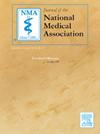从会议到职业:追踪斯坦福大学少数民族医学联盟(SUMMA)医学前会议校友的医学道路。
IF 2.5
4区 医学
Q1 MEDICINE, GENERAL & INTERNAL
引用次数: 0
摘要
尽管美国人口日益多样化,但少数种族和族裔在医疗保健行业的代表性仍然不足,导致健康差距持续存在。本研究评估了斯坦福大学少数民族医学联盟(SUMMA)医学预科会议在应对这些挑战方面的有效性。我们对2018年至2023年期间的238名前会议与会者进行了调查,以评估会议对他们在医学领域的教育和职业轨迹的影响。该调查采用李克特5分制考察了人口统计学变量、研究生意向和对会议影响的看法。85%的调查对象被确定为第一代医学生,其中西班牙裔/拉丁裔(30.67%)、黑人/非裔美国人(20.17%)和亚洲人(21.43%)的背景占很大比例。44%的人在会后申请了医学院,74%的人渴望或被医学院录取。卡方检验显示,43.75%的黑人/非裔美国人和37.67%的西班牙裔/拉丁裔受访者申请了医学院,而亚洲受访者的这一比例为28.57% (χ²=10.72,p=0.030);经济条件较差的学生申请医学院的比例为56.25%,而非经济条件较差的学生申请医学院的比例为30.91% (χ²=16.99,p=0.001)。Logistic回归显示,第一代和经济条件较差的学生申请医学院的几率更高(OR=4.84, p=0.005;或= 9.94,p本文章由计算机程序翻译,如有差异,请以英文原文为准。
From conference to career: Tracing medical pathways of Stanford university’s minority medical alliance (SUMMA) premedical conference alumni
Despite the growing diversity of the U.S. population, racial and ethnic minorities remain underrepresented in healthcare professions, perpetuating health disparities. This study evaluates the effectiveness of the Stanford University’s Minority Medical Alliance (SUMMA) Premedical Conference in addressing these challenges. We conducted a survey of 238 former conference attendees from 2018 to 2023 to assess the conference’s impact on their educational and career trajectories in medicine. The survey examined demographic variables, post-graduate intentions, and perceptions of the conference’s impact using a 5-point Likert scale. 85% of survey respondents identified as first-generation medical students, with significant representation from Hispanic/Latino (30.67%), Black/African-American (20.17%), and Asian (21.43%) backgrounds. 44% applied to medical school post-conference, and 74% aspired to or were enrolled in medical school. Chi-square tests revealed that 43.75% of Black/African-American and 37.67% of Hispanic/Latino respondents applied to medical school, compared to 28.57% of Asian respondents (χ²=10.72, p=0.030), and that 56.25% of economically disadvantaged students applied to medical school compared to 30.91% of those not disadvantaged (χ²=16.99, p=0.001). Logistic regression highlighted that first-generation and economically-disadvantaged students had higher odds of applying to medical school (OR=4.84, p=0.005; OR=9.94, p<0.001). Likert scale responses showed that 81.9% of respondents agreed that the conference increased their confidence in navigating medical school applications and 68.2% agreed that it increased their confidence in seeking advisors. By sharing the effectiveness of the SUMMA conference in supporting minority students, we provide a learning opportunity by which other institutions may engage their communities to increase diversity in healthcare education.
求助全文
通过发布文献求助,成功后即可免费获取论文全文。
去求助
来源期刊
CiteScore
4.80
自引率
3.00%
发文量
139
审稿时长
98 days
期刊介绍:
Journal of the National Medical Association, the official journal of the National Medical Association, is a peer-reviewed publication whose purpose is to address medical care disparities of persons of African descent.
The Journal of the National Medical Association is focused on specialized clinical research activities related to the health problems of African Americans and other minority groups. Special emphasis is placed on the application of medical science to improve the healthcare of underserved populations both in the United States and abroad. The Journal has the following objectives: (1) to expand the base of original peer-reviewed literature and the quality of that research on the topic of minority health; (2) to provide greater dissemination of this research; (3) to offer appropriate and timely recognition of the significant contributions of physicians who serve these populations; and (4) to promote engagement by member and non-member physicians in the overall goals and objectives of the National Medical Association.

 求助内容:
求助内容: 应助结果提醒方式:
应助结果提醒方式:


